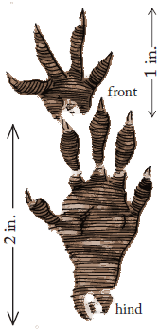Wildlife - Species

Species Specific Regulations
Muskrats
Licenses: Hunting License required.
Limits: Weapon restrictions according to game zones please check for Limitations.
Muskrat (Ondatra zibethica)

Muskrat tracks
Description
Muskrats have dark brown fur and a naked tail, which is flattened vertically. Muskrats get their name from the scent or "musk" glands at the base of the tail. They have partially webbed back feet for swimming, while the front feet possess long claws for digging plant roots.
Muskrats stand about 4 ½ inches at the shoulder and average about 2 lbs. in weight.
Life Expectancy
Approximately 2-4 years
Preferred Habitat
In the Piedmont muskrats are found in most aquatic areas. They reach their highest numbers in beaver ponds, though they may also be found in farm ponds, irrigation ditches, small streams, lakes or any other freshwater habitat. Below the fall line, muskrats are restricted to just a few counties in the northeast end of the Coastal Plain. The muskrat
may construct lodges or "huts" by piling up vegetation in shallow marshes, but like the beaver, muskrats prefer to burrow dens into ditches or stream banks. Along some of the state’s major reservoirs they have found ideal den sites by burrowing into the styrofoam beneath floating docks. This habit, of course, is not very popular with the dock owners.

Range
Muskrats are found in every state except Florida. They are common along the Gulf Coast and parts of the Atlantic, but are absent from coastal areas of South Carolina, Georgia and Florida. The reasons are not fully understood, but high salinity and tidal fluctuations may be responsible. South Carolina populations are found primarily in the Piedmont and in the northeastern section of the upper Coastal Plain.
Food Habits
Muskrats are primarily vegetarians, eating the roots, tubers and lower stems of cattails, bulrushes, smartweeds, waterlillies and duck potatoes. They will eat some agricultural crops, where available, and small amounts of animal matters such as clams, snails, and minnows.
Reproduction
Peak Breeding Activity
Muskrats are monogamous and have been known to breed throughout the year, although the majority of reproduction occurs in the spring and fall.
As many as 4 to 5 litters may be produced per year. The young are on their own by 1 month of age.
Gestation
about 28 days, and the average litter size is 3 to 6.
Miscellaneous
Mink, raccoons, hawks, owls, snakes, turtles and fish heavily prey upon muskrats. Nevertheless, overpopulation is common and results in a large amount of stress related mortality. Errington’s disease, a viral infection, spreads rapidly in dense populations.
Because of its abundance nationwide, and relatively consistent fur value, the muskrat is the most trapped furbearer in North America. During the period from 1974 through 1984 the average annual harvest in the United States was over 7 million. In South Carolina, muskrat trapping is popular but the total harvest falls below that of raccoons, opossums, red and gray foxes. The muskrat’s high reproductive potential allows it to compensate for a high rate of predation. Populations tend to be cyclical, and during a peak muskrats may overpopulate and drastically alter the habitat through the consumption of large quantities of aquatic vegetation. Trapping is the most effective means of controlling such high populations.
Publications and Literature
Baker, O.E., Carmichael, D. Breck, South Carolina Furbearers. Wildlife and Freshwater Fisheries Division. Columbia, South Carolina
Carmichael, Breck, Butfiloski, Jay, The Muskrat. (Adobe PDF) Wildlife and Freshwater Fisheries Division. Columbia, South Carolina
Muskrat Control - What a landowner CAN do in South Carolina (Adobe PDF)
Fur Harvest Hunting and Trapping are provided in the Fur Harvest Brochure which is a summary of the state statutes regarding the commercial harvest of furbearers. Applicable statutes are listed in parentheses at the end of each section of this brochure. Copies of actual statutes of the SC Code of Laws are available online from the SC Legislature at www.scstatehouse.gov or by writing: Furbearer Program, SC Department of Natural Resources, P.O. Box 167, Columbia, SC 29202.
Some of the files above are provided in the Adobe® Acrobat® (PDF) format. Adobe® Reader® is required to open these files and is available as a free download from the Adobe® Web site.
Jay Butfiloski - Furbearer Project Supervisor
SCDNR Furbearer Project
P. O. Box 167
Columbia, SC 29202-0167
Phone: 803-734-3886
Fax: 803-734-6020
E-mail: ButfiloskiJ@dnr.sc.gov
